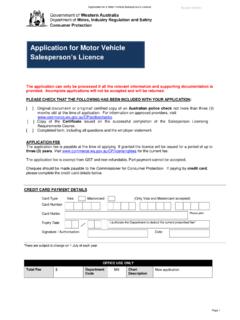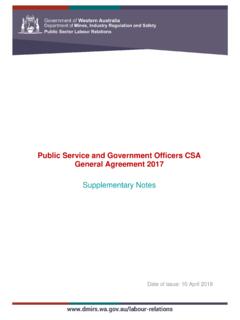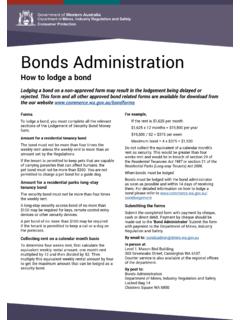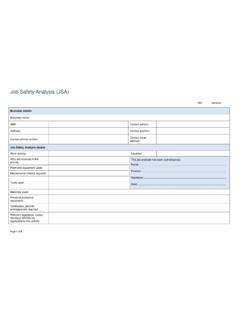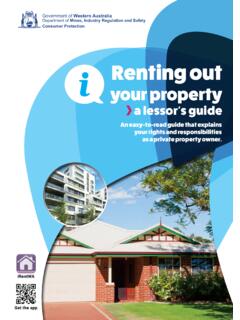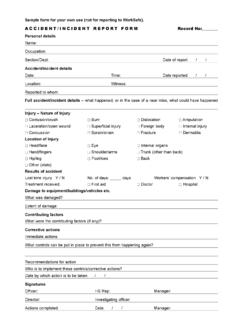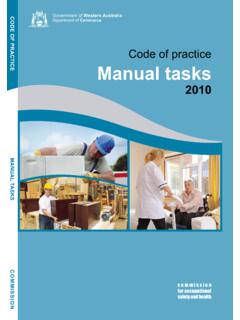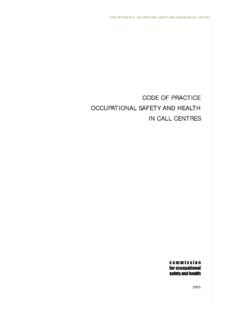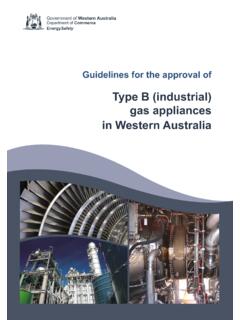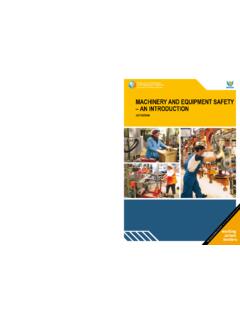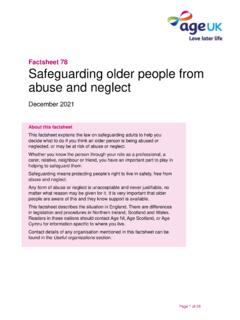Transcription of Code of practice - Safeguarding of machinery and plant
1 Commissionfor occupationalsafety and healthCode of practice Safeguarding ofmachinery and plant2009 CODE OF practice Safeguarding OF machinery AND plants afeguarding of machinery and 4 Safeguarding of machinery and 426/11/2009 1:39:18 PM26/11/2009 1:39:18 PMCODE OF practice Safeguarding OF machinery AND PLANTF orewordThis code of practice is issued by the Commission for Occupational Safety and Health (the Commission)and its Mining Industry Advisory Committee under the provisions of the Occupational Safety and Health Act 1984 (the OSH Act) and the Mines Safety and Inspection Act 1994 (the MSI Act).The introduction of the OSH Act enabled the establishment of the tripartite Commission.
2 It comprises representatives of employers, unions and government, as well as experts, and has the function of developing the occupational safety and health legislation and supporting guidance material, and making recommendations to the Minister for Commerce for their implementation. To fulfi l its functions, the Commission is empowered to establish advisory committees, hold public inquiries, and publish and disseminate Commission s objective is to promote comprehensive and practical preventative strategies that improve the working environment of Western Australians. This code of practice has been developed through a tripartite consultative process and the views of employers and unions, along with those of government and experts, have been Mining Industry Advisory Committee (MIAC) was established in April 2005 under the OSH Act as a statutory tripartite advisory body on matters relating to occupational safety and health in mining.
3 MIAC s objectives include making recommendations to the Minister for Mines and Petroleum regarding the formulation, amendment or repeal of laws under the MSI Act, and to prepare or recommend the adoption of codes of practice , guidance material, standards and specifi cations or other forms of guidance for the purpose of assisting employers, self employed persons, employees, manufacturers and others to maintain appropriate standards of occupational safety and health in the mining industry. MIAC may also advise and make recommendations to the Ministers and the Commission on occupational safety and health matters concerning the mining framework for occupational safety and healthOccupational Safety and Health Act 1984 The OSH Act provides for the promotion, co-ordination, administration and enforcement of occupational safety and health in Western OSH Act places certain duties on employers, employees, self -employed people, manufacturers, designers, importers and suppliers.
4 It also places emphasis on the prevention of accidents and addition to the broad duties established by the OSH Act, the legislation is supported by a further tier of statute, commonly referred to as regulations, together with a lower tier of non-statutory codes of practice and guidance Safety and Health Regulations 1996 Regulations under the Occupational Safety and Health Regulations 1996 (the OSH Regulations) spell out specifi c requirements of the may prescribe minimum standards and have a general application, or defi ne specifi c requirements related to a particular hazard or particular type of work. They may also allow licensing or granting of approvals and certifi Safety and Inspection Act 1994 The MSI Act sets objectives to promote and improve occupational safety and health standards within the minerals MSI Act sets out broad duties, and is supported by a further tier of statute, commonly referred to as regulations, supported by non-statutory codes of practice and Safety and Inspection Regulations 1995 The MSI Act is supported by the Mines Safety and Inspection Regulations 1995 (the MSI Regulations), which provide more specifi c requirements for a range of of machinery and 5 Safeguarding of machinery and 526/11/2009 1:39:19 PM26/11/2009 1:39.
5 19 PMCODE OF practice Safeguarding OF machinery AND plants cope and application of this codeIn October 2009, the Minister for Commerce approved this code of practice under Section 57 of the OSH Act and in November 2009 the Minister for Mines and Petroleum approved this code of practice under Section 93 of the MSI code of practice applies to all workplaces in Western Australia covered by either the OSH Act or the MSI Act. It provides: general guidance for employers, designers, manufacturers, suppliers and workers on the identifi cation and control of safety and health hazards and risks associated with guarding, or lack of guarding, of machinery and plant ; information on key legislative requirements in the OSH Act, the OSH Regulations, the MSI Act and the MSI Regulations as they relate to guarding of machinery and plant ; and practical guidance on guarding of machinery and plant commonly found in workplaces.
6 Codes of practice published under the OSH Act and MSI ActA code of practice is a document prepared for the purpose of providing: practical guidance on how to comply with a general duty under the OSH Act and MSI Act or specifi c duties under the OSH Regulations or MSI Regulations; without being prescriptive, practical guidance on safe work practices that can be used to reduce the risk of work-related injury and disease; and a practical means of achieving any code, standard, rule, provision or specifi cation relating to occupational safety and health in Western code of practice may contain explanatory information. However, work practices included may not represent the only acceptable means of achieving the standard to which the code refers.
7 Compliance with codes of practice is not mandatory but a code may be used by courts as the standard when assessing other methods or practices used. A code of practice does not have the same legal force as a regulation and non-compliance is not suffi cient reason, of itself, for prosecution under the OSH or MSI that there may be additional risks at the workplace not specifi cally addressed in this code of practice . Under the OSH Act and MSI Act, these must be identifi ed and control measures implemented to prevent or minimise of machinery and 6 Safeguarding of machinery and 626/11/2009 1:39:19 PM26/11/2009 1:39:19 PMCODE OF practice Safeguarding OF machinery AND PLANTSome of the text in this code was originally published by Workplace Health and Safety Queensland The State of Queensland 2006.
8 It has been reproduced with numbered 21, 25, 26, 27, 30 and 31 are reproduced with the permission of the Queensland Department of Justice and Attorney General (JAG). Copyright of these illustrations is owned by The information contained in this publication is provided in good faith and believed to be reliable and accurate at the time of publication. However, the information is provided on the basis that the reader will be solely responsible for assessing the information and its veracity and usefulness. The State shall in no way be liable, in negligence or howsoever, for any loss sustained or incurred by anyone relying on the information, even if such information is or turns out to be wrong, incomplete, out-of-date or this disclaimer: State means the State of Western Australia and includes every Minister, agent, agency, department, statutory body corporate and instrumentality thereof and each employee or agent of any of them; information includes information, data, representations, advice, statements and opinions, expressly set out or implied in this publication.
9 And loss includes loss, damage, liability, cost, expense, illness and injury including of machinery and 7 Safeguarding of machinery and 726/11/2009 1:39:19 PM26/11/2009 1:39:19 PMCODE OF practice Safeguarding OF machinery AND PLANTC ontents1. Introduction and purpose 1 Overview of duties 12. Risk management: the three step process 3 Step 1: Hazard identifi cation 4 Examples of hazards 7 Step 2: Risk assessment 13 Step 3: Risk control 15 Holistic approach 17 Implementing control measures 17 Monitoring and reviewing effectiveness of control measures 18 Keeping documents and records 183.
10 Guards and safety devices 19 Types of guards 19 Permanently fi xed barriers (guards) 19 Interlocked physical barriers (interlocked guards) 19 Physical barrier securely fi xed in position (fi xed guards) 20 Physical barriers 20 Presence-sensing systems 20 Two handed controls 22 Combination of guards 22 Safe system of work for unguarded areas 224. Considerations for designers, manufacturers, suppliers and purchasers 23 Responsibilities 23 Designing to eliminate or reduce machinery and plant hazards 23 Inherently safe design measures 24 Considering the life cycle during design 26 Basic rules for guard design 27 Servicing considerations 285.
